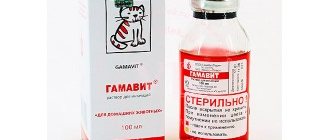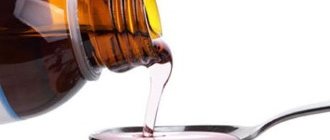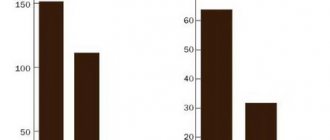Release form, packaging and composition of the drug Clinical-pharmacological group Pharmaco-therapeutic group Pharmacological action Indications for use Method of administration and doses Side effects Contraindications for use Use in children Special instructions Drug interactions
Registration Certificate Holder:
ADIPHARM, EAD (Bulgaria)
ATX Code:
N02BB52
Active substance:
fenpiverinium bromide
Dosage form:
Spasmoblock
| The drug is approved for use as an over-the-counter product | Spasmoblock | Tablets reg. No.: LSR-008173/10 from 02/20/13 - Indefinitely |
Release form, packaging and composition of the drug Spazmoblok
Pills
white with a slight yellowish tint, round, flat-cylindrical, with a notch on one side.
| 1 tab. | |
| metamizole | 500 mg |
| pitofenone (as hydrochloride) | 5 mg |
| fenpiverinium bromide | 100 mcg |
Excipients
: gelatin 4 mg, wheat starch 38.65 mg, lactose monohydrate 5 mg, magnesium stearate 4 mg, sodium bicarbonate 5 mg, talc 6 mg, microcrystalline cellulose 25 mg.
2 pcs. - blisters (1) - cardboard packs. 10 pieces. - blisters (2) - cardboard packs. 10 pieces. - blisters (10) - cardboard packs.
pharmachologic effect
Combined analgesic and antispasmodic agent. The combination of the components of the drug leads to a mutual enhancement of their pharmacological action. Metamizole sodium
- a pyrazolone derivative, has an analgesic, antipyretic and weak anti-inflammatory effect, the mechanism of which is associated with inhibition of prostaglandin synthesis.
Pitophenone hydrochloride
has a direct myotropic effect on the smooth muscles of internal organs and causes its relaxation (papaverine-like effect).
Phenpiverinium bromide
has an m-anticholinergic effect and has an additional myotropic effect on smooth muscles.
Pharmacodynamics
The drug Spazgan contains:
- Metamizole sodium is a non-narcotic analgesic, a derivative of pyrazolone. It is responsible for relieving pain, reducing temperature, as well as mild anti-inflammatory properties.
- Pitofena hydrochloride is a myotropic antispasmodic agent. Relaxes the smooth muscles of muscle tissue through direct action. The action extends to all internal organs
- Phenpiverinium bromide is the main choline blocker. An accompanying quality is a weak relaxing effect on muscle tissue.
These three substances, when combined, enhance the pharmacological properties of each component and contribute to the rapid relief of pain, relaxation of smooth muscles, and active reduction of high body temperature.
Indications for use
Pain syndrome (mild or moderate) with spasms of smooth muscles of internal organs: renal colic, spasm of the ureter and bladder; biliary colic; biliary dyskinesia; postcholecystectomy syndrome; intestinal colic; chronic colitis; algodismenorrhea; diseases of the pelvic organs. For short-term treatment of arthralgia; myalgia; neuralgia, sciatica. As an auxiliary drug for pain after surgical interventions and diagnostic procedures.
Directions for use and doses
The method of administration and dosage regimen of a particular drug depend on its release form and other factors. The optimal dosage regimen is determined by the doctor. The compliance of the dosage form of a particular drug with the indications for use and dosage regimen should be strictly observed.
Inside
Adults and adolescents over 15 years old: 1-2 tablets. 2-3 times a day, without chewing, with a small amount of liquid. Children aged 12-14 years: single dose - 1 tablet, maximum daily dose - 6 tablets. (1.5 tablets 4 times/day), children aged 8-11 years - 0.5 tablets, maximum daily dose - 4 tablets. (1 tablet 4 times/day), children aged 5-7 years - 0.5 tablet, maximum daily dose - 2 tablets. (0.5 tablet 4 times/day). Parenteral (i.v., i.m.)
For adults and adolescents over 15 years of age with acute severe colic, 2 ml are administered intravenously slowly (1 ml over 1 minute); if necessary, re-inject after 6-8 hours. IM - 2-5 ml of solution 2-3 times a day. The maximum daily dose should not exceed 10 ml (corresponding to 5 g of metamizole sodium).
The duration of treatment is determined depending on the clinical symptoms and etiopathogenesis of the disease, but should not exceed 5 days. Dose calculation for children with IV and IM administration: 3-11 months (5-8 kg) - IM only - 0.1-0.2 ml; 1-2 years (9-15 kg) - IV - 0.1-0.2 ml, IM - 0.2-0.3 ml; 3-4 years (16-23 kg) - IV - 0.2-0.3, IM - 0.3-0.4 ml; 5-7 years (24-30 kg) - IV - 0.3-0.4 ml, IM - 0.4-0.5 ml; 8-12 years (31-45 kg) - IV - 0.5-0.6 ml, IM - 0.6-0.7 ml; 12-15 years - IV and IM - 0.8-1 ml. Before administering the injection solution, it should be warmed in your hand.
Indications
Spazgan for injection
A spasm can occur even in a practically healthy person. It depends on the characteristics of the body, or its predisposition to a particular type of disease. The etiology of spasm is the involuntary contraction of muscle tissue of internal organs. Spasm always occurs accompanied by severe pain. Renal, intestinal, or gastric colic are antispasmodic phenomena of internal organs.
Acute pain accompanies inflammatory processes, both in biliary and urolithiasis. The pain is long lasting. To avoid painful shock, the patient needs to take a fast-acting painkiller. Such a remedy is Spazgan. Indications for use of the drug are any acute manifestation of pain with the exception of appendicitis.
The product is endowed with medicinal qualities. It not only situationally combats acute attacks of spasms, but also prevents their further occurrence, fighting the root cause of their manifestation. Spazgan is prescribed in a course of tablets or in the form of injections for 3 to 5 days. After receiving a course of Spazgan, almost all patients noted an improvement in their well-being and the absence of recurrent pain.
Side effect
Allergic reactions:
urticaria (including on the conjunctiva and mucous membranes of the nasopharynx), angioedema, in rare cases - malignant exudative erythema (Stevens-Johnson syndrome), toxic epidermal necrolysis (Lyell's syndrome), bronchospasm, anaphylactic shock.
From the hematopoietic system:
thrombocytopenia, leukopenia, agranulocytosis (may be manifested by the following symptoms: unmotivated rise in temperature, chills, sore throat, difficulty swallowing, stomatitis, as well as the development of vaginitis or proctitis).
From the cardiovascular system:
decreased blood pressure.
From the urinary system:
impaired renal function, oliguria, anuria, proteinuria, interstitial nephritis, red staining of urine.
Anticholinergic effects:
dry mouth, decreased sweating, accommodation paresis, tachycardia, difficulty urinating.
Local reactions:
with intramuscular injection, infiltrates are possible at the injection site.
Instructions for medical use of the drug Spazmoblok
Registration number: LSR-008173/10 Trade name: Spasmoblock International nonproprietary name (INN): Metamizole sodium + Pitofenon + Fenpiverinium bromide Dosage form: tablets
Each tablet contains: metamizole sodium monohydrate 527 mg equivalent to metamizole sodium 500 mg, pitofenone hydrofluoride 5.25 mg equivalent to pitofenone 5 mg and fenpivirinium bromide 0.1 mg. Excipients: wheat starch, microcrystalline cellulose, talc, sodium bicarbonate, lactose monohydrate, gelatin and magnesium stearate.
Description Round, flat-cylindrical tablets, white with a slight yellowish tint, scored on one side.
Pharmacotherapeutic group Combined analgesic (non-narcotic analgesic + antispasmodic).
ATX code: [N02BB52].
Pharmacological action of spasmoblock:
Pharmacodynamics of spasmoblock Metamizole sodium, a pyrazolone derivative, has an analgesic, antipyretic and weak anti-inflammatory effect, the mechanism of which is associated with inhibition of prostaglandin synthesis. Pitophenone is a myotropic antispasmodic that has a direct effect on the smooth muscles of internal organs and causes its relaxation. Fenpiverinium bromide is an m-anticholinergic blocker that has an additional antispasmodic effect on smooth muscles.
Pharmacokinetics of spasmoblock
Metamizole sodium: well and quickly absorbed from the gastrointestinal tract (GIT). It is hydrolyzed in the intestinal wall to form an active metabolite - unchanged metamizole sodium is absent in the blood (only after intravenous administration a small concentration is detected in the plasma). Connection of the active metabolite with plasma proteins: 50-60%. Metabolized in the liver, excreted by the kidneys. In therapeutic doses it passes into breast milk.
Pitophenone is rapidly absorbed from the gastrointestinal tract; maximum plasma concentration is achieved within 30 - 60 minutes; quickly distributed in organs and tissues and quickly excreted in the urine. The half-life is 1.8 hours. Phenpivernnia bromide is also rapidly absorbed from the gastrointestinal tract and reaches maximum concentration in blood plasma within 1 hour. 32.4 - 40.4% of the substance is excreted by the kidneys unchanged, 2.5 - 5.3% of the substance is excreted with bile.
Indications for use of spasmoblock
Mild or moderate pain syndrome due to spasms of smooth muscles of internal organs: renal colic, spasm of the ureter and bladder; biliary colic, intestinal colic; biliary dyskinesia of the hyperkinetic type, postcholecystectomic syndrome, chronic colitis, algodismenorrhea. For short-term treatment: arthralgia, myalgia, neuralgia, sciatica. As an auxiliary drug: diseases of the pelvic organs, pain syndrome after surgical interventions and diagnostic procedures.
Contraindications spasmoblock
Hypersensitivity to any of the drugs and/or excipients (including pyrazolone derivatives), inhibition of bone marrow hematopoiesis, severe liver and/or renal failure, glucose-6-phosphate dehydrogenase deficiency, lactase deficiency. lactose intolerance, glucose-galactose malabsorption, tachyarrhythmias, severe angina, closed-angle glaucoma, prostatic hyperplasia (with clinical manifestations), intestinal obstruction, megacolon, collapse, pregnancy, lactation, children under 8 years of age. The drug should be used with caution and under the supervision of a physician in case of impaired liver or kidney function, with a tendency to arterial hypotension, bronchospasm, hypersensitivity to non-steroidal anti-inflammatory drugs, a complete or incomplete combination of bronchial asthma, nasal polyposis and intolerance to acetylsalicylic acid and other non-steroidal anti-inflammatory drugs.
Directions for use and doses
Inside, after meals, with water. Frequency of administration: 2-3 times/day. Adults and adolescents over 15 years of age: 1-2 tablets 2-3 times a day. The maximum daily dose is 6 tablets.
For children, the dose of the drug is determined depending on age: at the age of 8-11 years, the recommended single dose is 1/2 tablet, the maximum daily dose is 4 tablets, 12-14 years old - 1 tablet, the maximum daily dose is 6 tablets. Duration of treatment: no more than 5 days. Increasing the daily dose of the drug or the duration of treatment is possible only under medical supervision.
Side effect spasmoblock
Frequency: very common (more than 10%), common (1-10%), uncommon (0.1-1%), rare (0.01-0.1%), very rare (less than 0.01%). From the digestive system: very rarely - burning sensation in the epigastric region, dry mouth. From the cardiovascular system: rarely - decreased blood pressure (BP), tachycardia.
From the hematopoietic system: very rarely (usually with long-term use) - thrombocytopenia, leukopenia, agranulocytosis (may be manifested by the following symptoms: unmotivated rise in temperature, chills, sore throat, difficulty swallowing, stomatitis, as well as the development of vaginitis or proctitis). From the urinary system: rarely (usually with long-term use or when prescribed in high doses) - impaired renal function, oliguria, anuria, proteinuria, interstitial nephritis, red staining of urine, difficulty urinating.
Allergic reactions: rarely - urticaria (including on the conjunctiva and mucous membranes of the nasopharynx), very rarely - angioedema, malignant exudative erythema (Stevens-Johnson syndrome), toxic epidermal necrolysis (Lyell's syndrome), bronchospastic syndrome, anaphylactic shock. Other: possible dizziness; very rarely, decreased sweating, accommodation paresis; in isolated cases - headache. Overdose
Symptoms: Vomiting, decreased blood pressure, drowsiness, confusion, nausea, pain in the epigastric region, impaired liver and kidney function, convulsions. Treatment: gastric lavage, taking activated carbon, symptomatic therapy. Interaction with other drugs
The simultaneous use of Spasmoblock with other non-opioid analgesics can lead to mutually enhanced effects. When used simultaneously, tricyclic antidepressants, oral contraceptives, and allopurinol disrupt the metabolism of metamizole sodium in the liver and increase its toxicity. When used simultaneously, barbiturates, phenylbutazone and other inducers of microsomal liver enzymes weaken the effect of metamizole sodium.
X-ray contrast agents, colloidal blood substitutes and penicillins should not be used during treatment with drugs containing metamizole sodium. With simultaneous use of cyclosporine, the concentration of the latter in the blood decreases. Metamizole sodium, displacing oral hypoglycemic drugs, indirect anticoagulants, glucocorticosteroids and indomethacin from its binding to plasma proteins, can increase the severity of their action. When used simultaneously, sedatives and tranquilizers enhance the analgesic effect of Spasmoblock. When used simultaneously with H1-histamine receptor blockers, butyrophenone and phenothiazine derivatives, amantadine and quinidine, the m-cholinergic effect of the drugs may be enhanced. When used simultaneously with ethanol, mutual enhancement of effects is possible.
special instructions
Metamizole sodium metabolite can cause red coloration of urine, which has no clinical significance and disappears after discontinuation of the drug. If agranulocytosis is suspected or thrombocytopenia is present, the drug should be discontinued. With long-term (more than a week) use of the drug, monitoring of the peripheral blood picture and the functional state of the liver is necessary. It is not permissible to use it to relieve acute abdominal pain (until the cause is determined). Patients with atonic bronchial asthma and hay fever have an increased risk of developing allergic reactions. During the period of use of the drug, you should not drink alcohol.
Impact on the ability to simplify vehicles and mechanisms
While taking the drug, it is not recommended to drive vehicles or engage in other potentially hazardous activities that require rapid psychomotor reactions.
Release form Tablets 10 tablets per blister. 2 and/or 10 blisters along with instructions for use in a cardboard pack.
Storage conditions : Protected from light at a temperature not exceeding 25°C. Keep out of the reach of children. Shelf life: 3 years.
Do not use after the expiration date stated on the package. Conditions for dispensing from pharmacies Without a prescription. Manufacturer: ADIFARM EAD ADIFARM EAD. 1700 Sofia, Boulevard Simeonovskoe highway 130, Bulgaria. Tel: (++359 2) 860 20 00; fax: (++359 2) 860 20 18. Representative office in the Russian Federation (organization receiving claims) 119590, Moscow, st. Mosfilmovskaya, 52, office No. 19 Tel./fax: (499) 147 14 23
Contraindications for use
Severe liver and/or renal failure; inhibition of bone marrow hematopoiesis; deficiency of glucose-6-phosphate dehydrogenase; tachyarrhythmia; severe angina; decompensated chronic heart failure; collapse; angle-closure glaucoma; prostatic hyperplasia (with clinical manifestations); intestinal obstruction; megacolon; pregnancy (especially the first trimester and the last 6 weeks); lactation period; children under 3 months of age or body weight less than 5 kg (for intravenous administration); children under 5 years of age (for tablets); hypersensitivity (including to pyrazolone derivatives).
Carefully :
renal/liver failure; bronchial asthma; tendency to arterial hypotension; hypersensitivity to NSAIDs; urticaria or acute rhinitis caused by taking acetylsalicylic acid or other NSAIDs.
Dosage of the drug
When making appointments, the table of patient age groups is taken into account:
- For young patients up to one year old, if necessary, Spazgan is administered exclusively intramuscularly at a daily dose not exceeding 1.2 ml.
- Age category from 12 months to 5 years. The dosage of Spazgan depends on the body weight, age of the patient and the degree of pain symptom. Daily dosage - from 0.4 to 3.2 ml.
- Age category 5 - 14 years. For this age category, the dosage of the drug is no more than 1 ml per injection. The number of injections per day is recommended by the attending physician, but not more than four times a day.
- The age group from 14 years old belongs to the adult category. Patients in this group are prescribed a tablet method of treatment. The patient takes 1-2 tablets depending on body weight four times a day. Of these: in breakfast, lunch and dinner before meals and one dose before bedtime.
The tablets are not chewable, have a bitter taste with a pronounced taste of analgin and are washed down with plenty of still drinking water.
special instructions
With long-term (more than a week) treatment, monitoring of the peripheral blood picture and the functional state of the liver is necessary. If agranulocytosis is suspected or thrombocytopenia is present, it is necessary to stop taking the drug. The use of the drug to relieve acute abdominal pain is unacceptable until the cause of the disease is determined. Intolerance is very rare, however the risk of developing anaphylactic shock after intravenous administration of the drug is relatively higher than after taking the drug orally. In patients with atopic bronchial asthma and hay fever, the risk of developing allergic reactions increases. Parenteral administration of the drug should be used only in cases where oral administration is impossible or absorption is impaired from the gastrointestinal tract. The intravenous injection should be carried out slowly, with the patient lying down and under the control of blood pressure, heart rate and respiratory rate. Particular care must be taken when administering more than 2 ml of solution (there is a risk of a sharp decrease in blood pressure). For intramuscular administration it is necessary to use long needle. When treating children under 5 years of age and patients receiving cytostatics, the use of metamizole sodium should only be carried out under medical supervision. Urine may turn red due to the release of a metabolite (no clinical significance). During treatment with the drug it is not recommended take ethanol. Impact on the ability to drive vehicles and operate machinery
During treatment, drivers of vehicles and persons engaged in potentially hazardous activities that require rapid psychomotor reactions should be careful.



